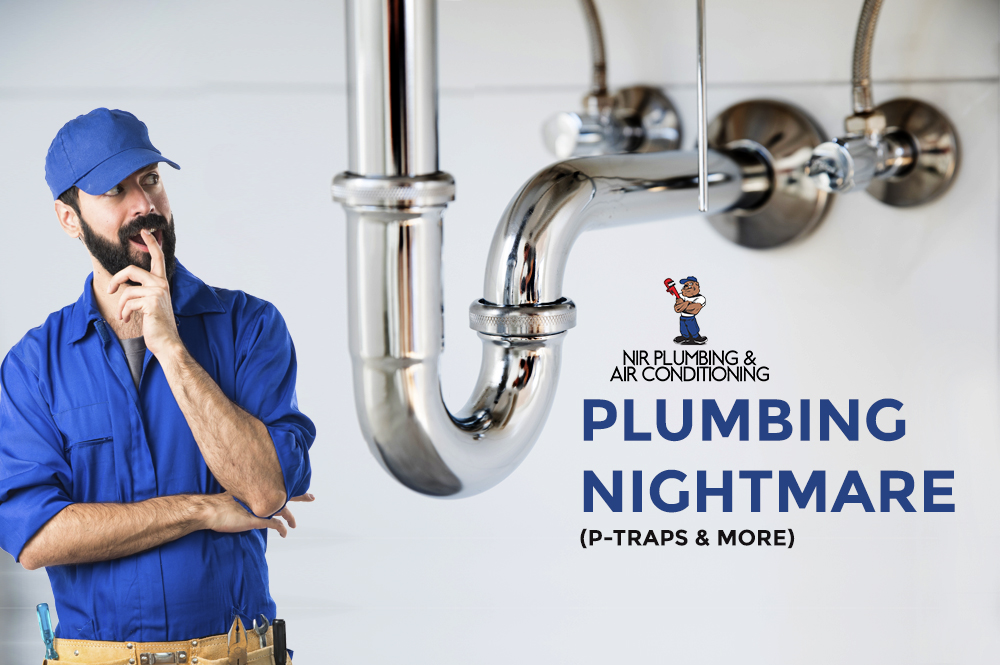[vc_row][vc_column width=”1/1″][vc_column_text]Overview: Taking a deep breath and not panicking when you’re dealing with an unexpected plumbing nightmare could be easier said than done, but these tips will help[/vc_column_text][vc_column_text]We plumbers sometimes shake our heads in disbelief at the things we face, so we know how overwhelming it could be when you’re faced with a plumbing nightmare as a homeowner.
Yes, plumbing could be an absolute nightmare — and this is especially true if the depth of the plumbing issue might have long-term affects on your living space.
There’s nothing that stings harder in a homeowner’s heart than a leaking pipe. As a homeowner, issues like leaking pipes or plumbing mishaps can cause a lot of damage to your property if left untreated. Here’s a quick guide for you to help when faced with those unexpected plumbing issues.[/vc_column_text][vc_column_text]
The Basics to Handling a Leakage or Blockage:
How to Handle a Basic Leak:
If water is coming from a pipe, the first thing you have to do is turn off the electricity supply.
The next step is to turn off the main supply of water.
As for now, get equipped with a decent amount of necessary tools before jumping in the sea. And, of course, wear something you don’t mind getting dirty.[/vc_column_text][vc_column_text]
How to Handle a Blockage:
If you’re facing a blockage, remove any obstruction first then investigate the plumbing issues by lifting the central hole and examining.This sounds like a dirty job, so wear rubber gloves before picking a tool.
Be sure to turn the rod clockwise while working – if you turn it anticlockwise, it will unscrew and get caught in the drain, which can cause another plumbing problem that will lead to another nightmare.
[/vc_column_text][vc_column_text]
How to Handle a Burst Pipe:
In the case of a pipe burst, choose a pipe repair clamp as a temporary solution. The clamp can either be screwed on or clamped into the burst area.
Alternatively, you could use self-fusing repair tape. Remove the grime or dirt from pipes, and cut around 20cm of tape while removing its backing.
Stretch the pipe to double-the-length and wrap it quickly while leaving the hole open. Wrap the tape around the line before covering the hole.[/vc_column_text][vc_column_text]
How to Unclog a Toilet or Stop it From Running:
If the water is taking a while to flush out or the water level rises, you know that you’re facing a blockage. While panicking is the first inclination people tend to go for, it’s best to keep that to a minimum.
Instead, arm yourself with a few essentials — rubber gloves, bleach, and drain flusher.
The next task is to locate the blockage. Once found, wear your gloves and remove the item. Watch this quick tutorial for further assistance.
If you’re dealing with a running toilet, remove the lid and examine the issue; flush the toilet to check the water level. Check the water valve if it’s fully on the water is below the line.
If that’s not the issue, check if the flapper valve is still open and not covering the valve. If that’s the issue, reach into the tank, readjust the flapper valve, and that should solve the problem. [/vc_column_text][vc_column_text]
Tools You Need:
- An adjustable spanner
- Lubricant
- A cross-hedge screwdriver
- Rubber gloves
[/vc_column_text][vc_column_text]
Stopping a Leaky Faucet:
A leaking tap is one of the easiest ways to drive yourself crazy. Trust us… we know from firsthand experience. The constant dripping water irritates the ears, and not to mention one home insurer, Axa, shares this piece of information: “Dripping taps lead to insurance claims totaling £387 million each year.”
So, how do we fix this? Well, there are two types of taps that require different process:
- Traditional Taps: The damages in these pipes are usually caused by a damaged washer that is replaceable.
- Monobloc Lever Tap: In these taps, the cause of leakage is a damaged ceramic cartridge. Replacement is the only solution.
We’ll address the latter point in the next section.[/vc_column_text][vc_column_text]
Dealing with an Old Cartridge:
Another big contributor to leaks over time is the aerator. This is the mesh filter at the end of the spigot. Over time, mineral deposits clog up the aerator.
You’ll lose water pressure as it clogs, and stress is placed on the seals and gaskets. In general, it’s a good idea to replace these every couple of years.
Read more about additional awesome leak hacks here.
[/vc_column_text][vc_column_text]
Preventing Future Plumbing Problems:
Once your temporary plumbing problems are solved, double-check that the nearby electric sockets are dry before turning the electricity on. Don’t rush turning them on without confirming the dry sockets.
Next, make sure that everyone in your home knows where the valves of your plumbing systems are to be inspected every couple of months to ensure that they can be turned off and on with ease.
Read more ways to prevent the damage by clicking here.
If you still find yourself dealing with a plumbing nightmare and you’re just about ready to wake up from this Freddy Krueger of a situation, we recommend you contact your local professional plumber so they can assess the situation and find you a solution that’s both affordable and effective.
[/vc_column_text][vc_column_text]
Articles you might be interested in:
- THINGS YOU SHOULD AVOID DOING TO YOUR PIPES
- HOME MAINTENANCE IN CALIFORNIA DURING THE WINTER: 5 WINTER PLUMBING TIPS
- THE BENEFITS OF 24-HOUR PLUMBING FOR PLUMBERS AND HOMEOWNERS
[/vc_column_text][/vc_column][/vc_row]


